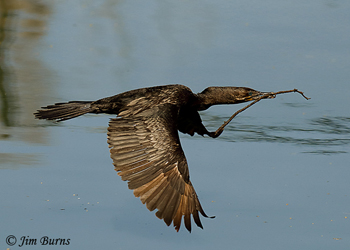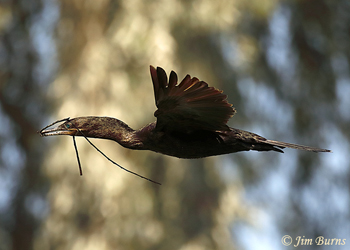|
|
| Neotropic Cormorants with wet branches for nests | |
I personally have witnessed three species using insightful intelligence, and I wrote about one of those incidents in a 2011 column--http://jimburnsphotos.com/pages/2-24-11.html. “Tool user” has been defined as an animal that uses a foreign object to influence its environment. Water would seem to qualify as a foreign object, particularly for birds that don’t live on or in the water, and I have often witnessed Great-tailed Grackles rendering berries easier to digest by softening them in rain puddles.
I recently observed a different species using water in a very different way which certainly seemed insightful to me. Last month I discovered a fishing pond, bordered by several huge Eucalyptus trees, in a small residential community in the east Valley. I first chanced upon it one morning shortly after sunrise and was surprised to find colonies of both Great Blue Herons and Neotropic Cormorants nesting, in close proximity to one another, hundreds of feet high in the tops of these trees.
There was really nothing surprising about this, and it appeared the herons had finished construction and might already be incubating, whereas the cormorants were still transporting branches to incorporate into their sprawling, ramshackle stick platform nests. After watching several Neotropics leave their nests and soon return with branches in beaks, I noticed that some of the branches sported greenery while others did not. No real surprise there, either, as we’ve all seen raptors and large water birds tearing dead branches from their actual nesting trees to weave into their platforms.
But then came the surprise. A cormorant flew by just above water level, below my position on the bank, and I saw water dripping from the branch it was transporting. Really intrigued now, I began watching comings and goings more carefully. Sure enough several Neotropics, upon leaving the nest, dropped directly into the water and dove. Expecting them to come up with fish, when I saw one emerge wrestling with a large, wet branch, it finally dawned on me that many of them were scouring the bottom of the pond itself, rather than their own or nearby trees, for building material.
Although I’d like to report I saw some actually dive into the pond with leafy branches already in tow, I did not see that. But at the very least it appears that some of the cormorants had learned wet branches were more pliable, and thus more useful, if thoroughly soaked by days or weeks “curing” in the water. It would also seem that bringing larger, longer branches from the water would be more energy efficient than trying to break off a dead branch of the same size from a living tree.
Perhaps cormorants should be considered “water” birds even though they do not build their nests in or on the water like rails and grebes. Perhaps water isn’t a “foreign” object to them because they rely on it for food (90% fish, but also frogs and dragonflies). Be that as it may, using water softened wood for weaving nests does not seem to me an instinctive behavior since all of them were not availing themselves of this life “hack.” Next spring I’m hoping to observe this rookery earlier in the spring to see if some Neotropic Cormorants don’t prove to be “smarter” than their heron neighbors.
